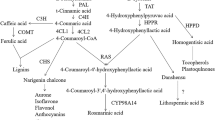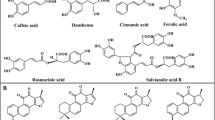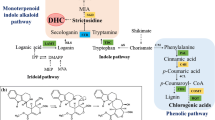Abstract
The non-protein amino acid β-aminobutyric acid (BABA) is a proven inducer of plant defense against pathogens. This work examines its effect on the production of diterpenoid tanshinones in Salvia miltiorrhiza hairy root cultures, both separately and in combination with a yeast elicitor (YE, the carbohydrate fraction of yeast extract). In the absence of YE, BABA at 0.1, 1 and 2 mM caused a dose-dependent enhancement of tanshinone accumulation, with up to a 4.5-fold increase (from 0.24 to 1.09 mg/g DW) in total content of three major tanshinones (cryptotanshinone, tanshinone I and tanshinone IIA) in the hairy roots. The combination of BABA with YE treatment further enhanced tanshinone production, but only when the BABA treatment was applied to the culture a few days before the YE treatment. Compared with methyl jasmonate, BABA was more effective in enhancing tanshinone production. A 3-day pretreatment with 1 mM BABA followed by YE-treatment, increased the total tanshinone content of roots by 9.4 times to 2.26 mg/g cells, and the volumetric tanshinone yield of culture by 6.3 times (from 3.2 to 20.1 mg/l). The results suggest that BABA can strongly potentiate elicitor-induced secondary metabolism in plant tissue cultures.




Similar content being viewed by others
References
Chen H, Chen F (1999) Effects of methyl jasmonate and salicylic acid on cell growth and cryptotanshinone formation in T I -transformed Salvia miltiorrhiza cell suspension cultures. Biotechnol Lett 21:803–807
Chen H, Chen F, Zhang YL, Song JY (1999) Production of lithospermic acid B and rosmarinic acid in hairy root cultures of Salvia miltiorrhiza. J Ind Microbiol Biotechnol 22:133–138
Chen H, Chen F, Chiu CK, Lo MY (2001) The effect of yeast elicitor on the growth and secondary metabolism of hairy root cultures of Salvia miltiorrhiza. Enzyme Microb Technol 22:133–138
Conrath U, Pieterse CMJ, Mauch-Mani B (2002) Priming in plant–pathogen interactions. Trends Plant Sci 7:210–216
Creelman RA, Mullet JE (1997) Biosynthesis and action of jasmonates in plants. Annu Rev Plant Physiol Plant Mol Biol 48:355–381
Doran PM (1997) Hairy roots: culture and applications. Harwood, Amsterdam
Dubois M, Gilles KA, Hamilton JK, Rebers PA, Smith F (1956) Colorimetric method for determination of sugar and related substances. Anal Chem 68:350–356
Eilert U (1987) Elicitation: methodology and aspects of application. In: Constabel F, Vasil I (eds) Cell culture and somatic cell genetics of plants, vol 4. Academic Press, San Diego, Calif., pp 153–196
Enyedi AJ, Yalpani N, Silverman P, Raskin I (1992) Signal molecules in systemic plant resistance to pathogens and pests. Cell 70:879–886
Gundlach H, Mueller MJ, Kutchan TM, Zenk MH (1992) Jasmonic acid is a signal transducer in elicitor-induced plant cell cultures. Proc Natl Acad Sci USA 89:2389–2393
Hahn MG, Albersheim P (1978) Host–pathogen interactions. XIV. Isolation and partial characterization of elicitor from yeast extract. Plant Physiol 62:107–111
Hu ZB, Alfermann AW (1993) Diterpenoid production in hairy root cultures of Salvia miltiorrhiza. Phytochemistry 2:699–703
Jakab G, Cottier V, Toquin V, Rigoli G, Zimmerli L, Métraux JP, Mauch-Mani B (2001) β-Aminobutyric acid-induced resistance in plants. Eur J Plant Pathol 107:29–37
Katz VA, Thulke OU, Conrath U (1998) A benzothiadiazole primes parsley cells for augmented elicitation of defense responses. Plant Physiol 117:1333–1339
Kauss H, Jeblick W (1995) Pretreatment of parsley suspension cultures with salicylic acid enhances spontaneous and elicited production of H2O2. Plant Physiol 108:1171–1178
Kauss H, Krause K, Jeblick W (1992) Methyl jasmonate conditions parsley suspension cells for increased elicitation of phenylpropanoid defense responses. Biochem Biophys Res Commun 189:304–308
Linden JC, Phisalaphong M (2000) Oligosaccharides potentiate methyl jasmonate-induced production of paclitaxel in Taxus canadensis. Plant Sci 158:41–51
Tang W, Eisenbrand G (1992) Chinese drugs of plant origin: chemistry, pharmacology, and use in traditional and modern medicine. Springer, Berlin Heidelberg New York, pp 891–902
Zhang C, Qiong Y, Cheuk W, Wu J (2004) Enhancement of tanshinone production in Salvia miltiorrhiza hairy root culture by Ag+ and nutrient feeding. Planta Medica 70:147–151
Zimmerli L, Jakab G, Métraux JP, Mauch-Mani B (2000) Potentiation of pathogen-specific defense mechanisms in Arabidopsis by β-aminobutyric acid. Proc Natl Acad Sci USA 97:12920–12925
Zimmerli L, Metraux JP, Mauch-Mani B (2001) β-Aminobutyric acid-induced protection of Arabidopsis against the necrotrophic fungus Botrytis cinerea. Plant Physiol 126:517–523
Acknowledgements
This work was supported by grants from the Hong Kong Polytechnic University (PD93 and ASD fund) and the Areas of Excellence Scheme established under the University Grants Committee of the Hong Kong SAR, China (AoE/P-10/2001)
Author information
Authors and Affiliations
Corresponding author
Rights and permissions
About this article
Cite this article
Ge, X., Wu, J. Induction and potentiation of diterpenoid tanshinone accumulation in Salvia miltiorrhiza hairy roots by β-aminobutyric acid. Appl Microbiol Biotechnol 68, 183–188 (2005). https://doi.org/10.1007/s00253-004-1873-2
Received:
Revised:
Accepted:
Published:
Issue Date:
DOI: https://doi.org/10.1007/s00253-004-1873-2




